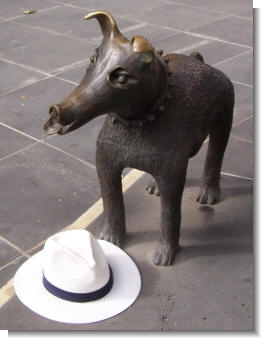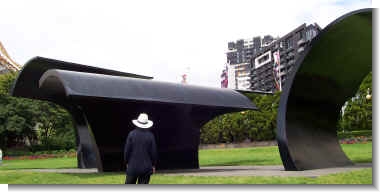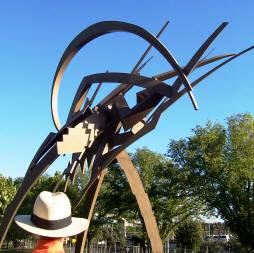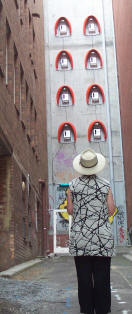Art before Melbourne
Melbourne was the name given to the European settlement commenced by
Batman and
Fawkner in 1835. Aboriginal people
lived in the area tens of thousands of years before the arrival of Europeans
and had a complex culture and art. We leave commentary on Aboriginal art in
this period to those better placed to do so. However we thoroughly
recommended a visit to the Aboriginal Gallery at the
National Gallery (Australian
Collection) to all visitors to Melbourne.
What is public art?
There are many parts of our built environment that display great craft
and are artistically pleasing but are not necessarily labeled as 'art'. On
the other hand there are many objects which show little craft or depth of
thinking but are funded by an arts budget or are labeled by their creators
as 'art'. (It is worth noting that anything that has to label itself xxxx
Art such as Mural Art or Graffiti Art is already
indicating that it has not generally been recognised as art and therefore
using xxxx Art as a marketing label.) Some art destroys the
art that went before it (see
Melbourne's Disappearing Hidden Gems from our Melbourne newsletter
No.151). So what constitutes public art?
Since long before the existence of Melbourne the question "what is
art?" has sparked fierce debate. At White Hat we don't claim to have a
definitive answer and will leave it for you to decide what belongs under the
label Public Art.
Public Monuments & Memorials
In Melbourne there are public memorials, often in the form of statues, to
people directly associated with Melbourne such as
Governor Charles La Trobe,
Tommy Bent,
Justice Higinbotham,
Adam Lindsay Gordon,
Burke & Wills, ,
Sir Rupert Hamer, John Cain, Sir Henry
Bolte, Weary Dunlop,
Sir Redmond Barry,
Francis Ormond,
Sidney Myer,
John Batman,
John Fawkner.
George Marshall-Hall and many
others. Photos of these monuments can be found at many of the pages linked
above.
In addition, reflecting Victoria's roots as a British Colony and the fact
that the monarch of Britain is still Australia's head of state, there are
various monuments and memorials to monarchs and 'heroes of the empire' who
never visited Melbourne. These include
Queen Victoria, King Edward VII, Governor Gordon of Khartoum and Nurse
Cavell.
There are also memorials and monuments to people of international
significance including John F Kennedy and Raoul Wallenberg.
Some monuments have an important part in Melbourne history but often go
un-noticed. You can read some of these at
The White Hat Guide to 7 Monuments
of Melbourne.
Because Melbourne is a very young city and much of it was created by
private rather than public initiative, there is little surprise that many of
the public memorials are a result of individuals or the wider public
contributing funds to create monuments to ensure that the life and work of a
particular individual should not be forgotten. There is thus a certain irony
in the current fashion for publicly funded conceptual art to denigrate the
people who wished these achievements to be remembered and, similarly in the
number of these monuments which have become covered with 'unofficial street
art' in the form of graffiti.
Other public monuments commemorate events or heritage associated with the
site. Like all Australian cities, Melbourne has numbers of memorials to the
First and Second World Wars, many of them in the precinct of the
Shrine of Remembrance. Some other
memorials include those to Victoria's women pioneers and the Old Melbourne
Cemetery.
Not all public memorials are good art - that is often not their purpose
and the public artist has to satisfy almost as many conflicting requirements
as artists working under patronage in the Renaissance courts. The monument
needs to reflect the attitudes and mores of the time and the funders. Most
of Melbourne's nineteenth century monuments were the result of private
benefactors and public subscriptions and the artist would usually be
expected to submit and modify designs for the people who were paying for the
monument. By the earlier part of the the twentieth century some monuments
were funded by governments using public money and the artist would usually
be expected to create a monument that was acceptable to the public at large
and/or the government of the day. In more recent times the artist may not
have to please the government or the public but to please the bodies and
committees that dispense public monies for such art.
In addition the artist needs to be aware of the language and iconography
of western art -who should appear on horseback and in what position and so
on. A walk through the
Domain presents
number of examples of public art making use of this language and symbolism.
Even if the artist chooses to thumb his/her nose at such artistic language
they need to know what impact that will have on the informed viewer.
When you observe the public memorials in central Melbourne, there were
only two until the 1920s that were for a women (and both of them English).
Later a small bust of Nellie
Melba appeared, and now (reflecting current values) the only significant
new additions have been of sportswomen such as Betty Cuthbert. Even though
we have listed numbers of women associated with Melbourne in our
200 Significant
Australians (such as Caroline Chisholm,
Louise Hanson-Dyer and
Mary MacKillop) you
won't find a major memorial to any of them in the centre of Melbourne.
The lack of Aboriginal people represented in such memorials is not
surprising as many Aboriginal cultures forbid the representation of the
deceased. However there is a representation of Bungaree.
Ronald Ridley's book Melbourne Monuments is the best
available guide to public monuments in Melbourne. It is well researched,
well written with numbers of insights into Melbourne's history, and provides
a suggested self-guided walking tour of these monuments. For a different style
of monument you can take a guided
walking tour of Melbourne General Cemetery.
Civic Art

Vault
|
The public sculpture Vault (known unkindly by many in Melbourne as
The Yellow Peril) can be found outside
ACCA. This sculpture caused an outcry
when first placed in the
City Square - firstly because it was modern and confronting to
Middle Melbourne and secondly
because it didn't seem in sympathy with the surrounding architecture. It was
subsequently banished from the centre of the city and publicly funded art in
Melbourne has since been restricted much more to the whimsical or smaller
scale politically correct decoration or temporary installations. Laudable
though these projects may be in supporting artists still learning their
craft, the better public art in recent time has usually come from
commissions from corporations, larger organisations and public benefactors
who can be more concerned with artistic merit and less with being re-elected
or satisfying the agendas of funding bodies.
The ones which seem to best characterise Melbourne today have a sense of
whimsy. The Three Businessmen Who Brought Their Own Lunch, Larry
Latrobe, weather vanes, The Public Purse, Brunswick street street
signs.

The Public Purse
|
|

Larry Latrobe
|
|
Displayed Art
Some public art in Melbourne was not specifically designed for the place
in which it stands. Stand alone sculptures were often purchased by the city
burgers or donated by public spirited citizens and erected outside public
buildings or in our parks. Good examples can be found outside the
State Library (dating from the time
it was also our art gallery) and in our
city parks and gardens.
Public Art as part of the Urban Landscape

Forward Surge
|
Much public art in Melbourne has been commissioned, created or chosen to
form part of the urban landscape and enhance the experience of living,
working or passing through a particular precinct.
When the
Docklands area
was redeveloped starting in the 1990s, developers were required to set aside
a portion of their budget for public art. As a result this area has some of
the greatest concentration of public art works in Melbourne. Outside the
Dockland Stadium are the works
Threaded Field and Art Wall, while close by is John Kelly's
Cow up a Tree with its oblique reference to
William Dobell. The
shiny white sculptures at Newquay are Silence by Adrian Mauriks.
Many buildings choose to enhance their public spaces - forecourts,
atriums, etc - with sculpture and other art.


Architectural
Good architecture is of course a form of public art and has been referred
to as "inhabited sculpture". However a number of Melbourne buildings,
particularly those dating from the nineteenth century, incorporate sculpture
into their facades and architectural decorations. Good (and bad) examples
can be found in much of Collins Street as well as on our two major
cathedrals. (One has a gargoyle from the 1990s with its mouth wide open
which purportedly represents a premier and art minister of that time). You
can find more recent examples in the large bronze figures that
Nonda Katsalidis has integrated
into the base of his city apartment buildings and in mobile sculptures.
Perhaps the most common form of art incorporated into the structure of a
building is the mural. At best they complement the structure and at their
worst they seem 'stuck on'. There is a large mural at Eastern Hill Fire
Station. You will find a Napier Waller
fresco above the door at the T&G
Building (now KPMG House). You can find a characteristic
Mirka Mora mural at the
Princes Bridge end of
Flinders Street Station in Swanston Street. as well as in the restaurant
Tollarno in St Kilda. For more information on Murals see The White Hat Guide to 7 Murals of
Melbourne.
The modern Republic Tower (designed by
Nonda Katsalidis) on the corner of
Queen & Latrobe streets is unusual in that incorporates a large public art
display area into the facade of the building. The artworks change four times
a year.
Semi-Public (art in city buildings etc.)
Much public art in Melbourne is in buildings which may be only open to
the public at certain times and under certain conditions. Public buildings
such as Parliament House may have
restricted access depending on their daily functions. Theatres and sporting
arenas may only be open to paying customers. Licensed premises such as Young
& Jackson's (the home of Chloe)
are likely to have age and dress requirements. Commercial buildings are
unlikely to welcome tour groups that disrupt their daily business. Certain
clubs may only be open to guests of members and certain corporate and
government areas may require an appropriate dress and behavior code and
introduction from a trusted client. Thus there is quite a continuum of what
may or may not be considered as 'public'.
The
Royal Exhibition Building
has an extensively painted interior in the grand Victorian style while the
main hall of the
Melbourne Town Hall
features large panels by ..
The mural Symmetry of Sport and Italian glass mosaic tiles
both designed by Leonard French can be seen in the trophy hall of
Beaurepaire Centre at Melbourne University.
 |
Jeffrey Smart
Container Train
in Landscape
|
Jeffrey
Smart's Container Train in Landscape
was commissioned in 1983 to hang in the foyer of the Fairfax Theatre
of the
Melbourne Arts Centre.
The painting comes into view at the top of the entrance stairs, and
by cunning use of forced perspective the train appears to remain at
the same distance as the viewer descends the stairs. It is painted
on five panels. As a consummate craftsman, Smart integrates the
painting with the colours and columns of the foyer, and as a
consummate artist uses numbers of visual devices to extract beauty
form a seemingly unpromising subject.
Those who know the painting well may notice that
the above image (from the website of the organisation selling the
print) is in fact a mirror image of the original. Never fear - if
you buy the print it is the right way round.
|
This large mural (20m by 3.6 m) is made up of 66 panels of
jewellery enamel on copper. The mural is in the form of a "line drawing"
which Nolan applied to the enamel with finger and thumb before the copper
sheets were then fired. The subject is the Eureka Stockade civil
uprising on the Ballarat goldfields in 1854 which forms an important part of
Australia's history. The work was created in collaboration with the
enamellers Patrick Furse and Robin Banks. Even though the foyer where it is
located is usually closed at night, the mural is illuminated and clearly
visible through the windows during the evening.
Location: Ground Floor Foyer, Reserve Bank of Australia,
60 Collins Street, Melbourne
Art Installations & Changing Displays
In recent years, government bodies such as the City of Melbourne have
funded numbers of temporary installations - usually in the style of
Conceptual Art. Below are some current examples:

see also a
recent encounter
Unofficial and Alternative Art
If none of the above is to your taste you can search out the council�s
art in the laneways projects. For instance in Hosiers Lane and off Centre
Place you are likely to find examples of stencil art and cultural jamming.
Cultural jamming is the technique of using images or icons from a given
culture but changing the message conveyed. Much of what is being �jammed� in
the alleys is commercial and popular culture, but as none of us from White
Hat has ever decided to immerse ourselves in commercial culture (we would be
useless in a trivia quiz that required us to know advertising jingles) the
messages are largely lost on us.
The White Hat Quiz
- Various statues in
The Domain
and connected gardens show people on horseback. How can you tell the
status of a person from a 19th century equestrian statue?
| To find the answers to questions like these ask a White Hat
Accredited Guide or subscribe to our
free
newsletter where similar questions and answers are provided each
week. For a sample of previous questions see
The White Hat Quiz. |
White Hat Website Feedback
“I have been using the white hat for well over 10 years. Thanks heaps! "
William K.
White Hat Website Feedback
“Thank you for excellent informative website - very appreciated.”
Deb
White Hat Website Feedback
“Just love the White Hat. Keep up the fab work !!!! You're a credit to Melbourne tourism"
Anna
White Hat Website Feedback
“This site is fantastic! Its always the one I visit when I want to know what's happening in Melbourne. And I always learn something new as well ! "
Tanzy